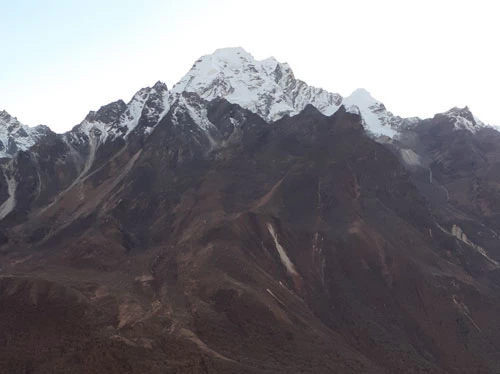Raised above the Lobuche village Lobuche East Peak is 6,119 meters peak which is one of the popular trekking peaks in the Everest region. Lobuche East Peak was submitted first by Laurence Nielsson and Ang Gyalzen Sherpa on April 25, 1984.
Although Lobuche East Peak is not a very technical mountain, the summit demands a good number of physical effort as it is a challenging peak, unlike another famous climbing peak, the island peak (6189M) near the region.
Climbing Lobuche East Peak, you can have the best mountaineering experience while being in this region. Being on the summit of the peak many of the Khumbu region’s highest mountains can be seen such as Mount Everest, Nuptse, Lhotse, Pumori, Ama Dablam, Tawoche, Cholatse, and many other peaks along with a beautiful valley down below.
For the Lobuche East Peak expedition, we trek through the Khumbu valley of the Everest region following the famous Everest base camp trail. The journey starts after landing at Lukla airstrip (2840M) and continues to Phakding (2610M) and Namche bazaar (3440M) on the first and the second night of the trek.
In Namche Bazaar we take an acclimatization day in which we hike to a famous landmark of the region, Everest View Hotel (3880M). The trek continues to Tengboche on our next day which has a 400-year-old monastery. Then, on the 5th day go to the dryer region of Dingboche (4400M) where we take another acclimatization day in which we hike to NangkarTshang hill (5091M).
After this, our journey goes to the higher region of the trek to Lobuche (4920M) and then goes to Gorak Shep (5160M) on the following day, on this day we detour to Everest base camp (5364M). The next morning, we went back down to Lobuche after our morning climb onto Kala Patthar (5545M) from where we can take in great views of the high mountains, Khumbu glacier, and the valley.
Hereafter the real adventure of mountaineering begins when you get to Lobuche base camp (5050M) where you get some climbing training and instruction before kickoff. The next day before submitting it goes to Lobuche East Peak High Camp (5600M) and there as well you have plenty of time to acclimatize.
On your summiting day, you start up early morning around 2 to 3 AM, and after having breakfast it goes higher ground to the crampon point where you suit up the climbing gears. Then the trail all treads upon the glacier to the Lobuche East Peak summit (6119M) which rewards you with unparalleled mountains, valleys, glaciers, and lakes.
On our journey back we retraced the same trail back to Lukla and took a flight back to Kathmandu to end the journey.
How difficult is climbing to Lobuche East Peak?
Lobuche East Peak is listed as one of the trekking peaks among 33 designated peaks in Nepal. Although it has some even 45 to 50 degrees angled inclination route to the summit, this peak is less technical and has a high success rate of 8 out of 10 climbers.
The walk to high camp begins from Lobuche base camp which is about 5050 meters then it steeply climbs up on the hill and eventually through a rocky trail to high camp at 5600m. Then the trail scrambles on rock slabs for a while and continues on rocky steep trails until crampon points.
After putting on crampons, climbing goes on through the ice and taking some fixed rope in between to the summit where your skill on using an ascender, ice ax, crampons, and rope handling come in handy. So overall, it is not that technical but does ask for a good amount of physical fitness and endurance.
How much is the permit cost for climbing Lobuche East Peak?
The cost of the climbing permit for Lobuche Peak (east) differs according to the season during the spring season which is from “March to May”, it costs USD 250 per head whereas during the autumn season which is “From September to November” and it only costs half which is USD 125 per head. Moreover, during the summer season, it only costs USD 70 per head for a climbing permit.
Likewise, you also have to deposit USD 500 for the Garbage deposit which is refundable after your climbing is done.













